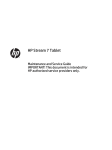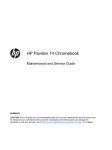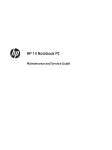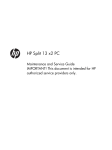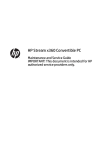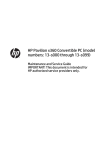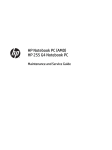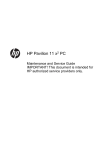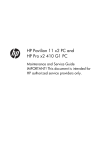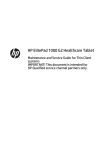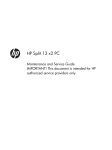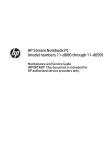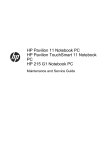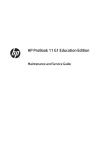Download HP Pavilion x2 Detachable Notebook PC HP Split x2 Detachable PC
Transcript
HP Pavilion x2 Detachable Notebook PC HP Split x2 Detachable PC Maintenance and Service Guide IMPORTANT! This document is intended for HP authorized service providers only. © Copyright 2014 Hewlett-Packard Development Company, L.P. Intel is a trademark of Intel Corporation in the U.S. and other countries. Microsoft and Windows are U.S. registered trademarks of Microsoft Corporation. SD Logo is a trademark of its proprietor. The information contained herein is subject to change without notice. The only warranties for HP products and services are set forth in the express warranty statements accompanying such products and services. Nothing herein should be construed as constituting an additional warranty. HP shall not be liable for technical or editorial errors or omissions contained herein. First Edition: June 2014 Document Part Number: 764169-001 Product notice This guide describes features that are common to most models. Some features may not be available on your computer. Not all features are available in all editions of Windows 8. Your computer may require upgraded and/or separately purchased hardware, drivers, and/or software to take full advantage of Windows 8 functionality. See http://www.microsoft.com for details. Important Notice about Customer Self-Repair Parts CAUTION: Your computer includes parts that should only be accessed by an authorized service provider. Accessing parts described in the chapter titled, "Removal and replacement procedures for Authorized Service Provider only parts," can damage the computer or void your warranty. iii iv Important Notice about Customer Self-Repair Parts Safety warning notice WARNING! To reduce the possibility of heat-related injuries or of overheating the device, do not place the device directly on your lap. Use the device only on a hard, flat surface. Do not allow another hard surface, such as an adjoining optional printer, or a soft surface, such as pillows or rugs or clothing, to block airflow. Also, do not allow the AC adapter to contact the skin or a soft surface, such as pillows or rugs or clothing, during operation. The device and the AC adapter comply with the user-accessible surface temperature limits defined by the International Standard for Safety of Information Technology Equipment (IEC 60950). v vi Safety warning notice Table of contents 1 Product description ....................................................................................................................................... 1 2 External component identification ................................................................................................................. 4 Tablet edge components ....................................................................................................................................... 4 Display ................................................................................................................................................................... 6 Keyboard dock ....................................................................................................................................................... 7 Top ....................................................................................................................................................... 7 TouchPad ............................................................................................................................................. 8 Lights ................................................................................................................................................... 9 Keys ................................................................................................................................................... 10 Front .................................................................................................................................................. 11 Right side ........................................................................................................................................... 12 Rear side ............................................................................................................................................ 12 Locating system information .............................................................................................................................. 13 3 Illustrated parts catalog .............................................................................................................................. 14 Tablet components .............................................................................................................................................. 14 Keyboard dock parts ............................................................................................................................................ 16 Hinge assembly parts .......................................................................................................................................... 17 Miscellaneous parts ............................................................................................................................................. 18 Sequential part number listing ........................................................................................................................... 18 4 Removal and replacement procedures preliminary requirements .................................................................... 21 Tools required ...................................................................................................................................................... 21 Service considerations ........................................................................................................................................ 21 Plastic parts ....................................................................................................................................... 21 Cables and connectors ...................................................................................................................... 21 Drive handling ................................................................................................................................... 22 Grounding guidelines ........................................................................................................................................... 22 Electrostatic discharge damage ....................................................................................................... 22 Packaging and transporting guidelines ......................................................................... 23 Workstation guidelines ................................................................................................... 23 Equipment guidelines ..................................................................................................... 24 5 Removal and replacement procedures for Authorized Service Provider parts ................................................... 25 Releasing the tablet from the keyboard dock .................................................................................................... 25 vii Keyboard dock components ................................................................................................................................ 26 Dock bottom cover ............................................................................................................................ 26 Battery cable ..................................................................................................................................... 28 HDMI board ........................................................................................................................................ 29 USB/audio board ............................................................................................................................... 30 I/O board ............................................................................................................................................ 32 Power connector ............................................................................................................................... 34 Hinge assembly ................................................................................................................................. 35 Battery ............................................................................................................................................... 40 Card reader board ............................................................................................................................. 41 Touchpad board ................................................................................................................................ 42 Tablet components .............................................................................................................................................. 44 Tablet cover ....................................................................................................................................... 44 Battery cable ..................................................................................................................................... 46 Cables, docking and touch ................................................................................................................ 47 Home button board ........................................................................................................................... 48 Hard drive .......................................................................................................................................... 49 Power connector/SIM board ............................................................................................................. 51 Volume board .................................................................................................................................... 53 Audio/SD board ................................................................................................................................. 54 Light sensor board ............................................................................................................................ 55 Dock board ........................................................................................................................................ 56 Touch screen board ........................................................................................................................... 57 WLAN/Bluetooth combo card ........................................................................................................... 59 SIM module ........................................................................................................................................ 61 Power button board .......................................................................................................................... 62 Speakers ............................................................................................................................................ 63 Battery ............................................................................................................................................... 64 System board .................................................................................................................................... 65 Webcam ............................................................................................................................................. 67 Antennas (WLAN, SIM) ....................................................................................................................... 69 6 Using Setup Utility (BIOS) and HP PC Hardware Diagnostics (UEFI) ................................................................... 71 Starting Setup Utility (BIOS) ................................................................................................................................ 71 Updating the BIOS ................................................................................................................................................ 71 Determining the BIOS version ........................................................................................................... 71 Downloading a BIOS update .............................................................................................................. 72 Using HP PC Hardware Diagnostics (UEFI) .......................................................................................................... 72 Downloading HP PC Hardware Diagnostics (UEFI) to a USB device .................................................. 73 viii 7 Specifications ............................................................................................................................................. 74 Computer specifications ...................................................................................................................................... 74 33.8-cm (13.3-in) display specifications ............................................................................................................ 75 8 Backing up, restoring, and recovering ........................................................................................................... 76 Creating recovery media and backups ................................................................................................................ 76 Creating HP Recovery media ............................................................................................................. 76 Restore and recovery .......................................................................................................................................... 77 Recovering using HP Recovery Manager .......................................................................................... 78 What you need to know .................................................................................................. 78 Using the HP Recovery partition (select models only) .................................................. 78 Using HP Recovery media to recover ............................................................................. 79 Changing the computer boot order ................................................................................ 79 Removing the HP Recovery partition (select models only) .............................................................. 79 9 Power cord set requirements ........................................................................................................................ 80 Requirements for all countries ........................................................................................................................... 80 Requirements for specific countries and regions ............................................................................................... 80 10 Recycling .................................................................................................................................................. 82 Index ............................................................................................................................................................. 83 ix x 1 Product description Category Description Product Name Processors Tablet Dock HP Pavilion x2 Detachable PC √ √ HP Split x2 Detachable PC √ √ Tablet: √ Intel® Core™ i5-4202Y (1.6-GHz, 3-MB L3 cache, 4.5 W) Intel Core i3-4012Y (1.5-GHz, 3-MB L3 cache, 4.5 W) Chipset Tablet: √ Integrated SoC PCH Graphics Tablet: √ Internal graphics 2D/3D Graphics Supports HD playback, streaming, and recording @ 1080p 30fps processors Panel Tablet: √ 33.8-cm (13.3-in), HD, anti-glare, LED (1366×768), slim 3.0-mm. UWVA, 200 nits 33.8-cm (13.3-in), FHD, anti-glare, LED (1920×1080), slim 3.0-mm. UWVA, 400 nits Supports 16:9 ultra wide aspect ratio Support for eDP, touch screen, multi-touch enabled Memory Tablet: √ Supports up to 8-GB system memory DDR3L-1600-MHz, single channel support Intel Haswell Y Supports up to 8 GB: 8192 (8192 × 1) 4096 (4096 × 1) Storage Tablet: √ Supports 500GB (5400 rpm) + 16 GB NAND Hybrid + Free Fall Sensor HDD, 5 mm Supports 500GB (5400 rpm) + 8 GB NAND Hybrid + Free Fall Sensor HDD, 5 mm Audio Tablet: √ Two integrated stereo speakers Beats Audio Webcam and microphone Tablet: √ Webcam, 1080p by 30 frames per second 1 Category Description Tablet Dock Dual array Digital Microphones w/ appropriate software - beam forming, echo cancellation, noise suppression Sensors Tablet: √ Accelerometer Gyroscope eCompass Wireless Tablet: √ Integrated WLAN options by way of wireless module Dual antennas Supports the following WLAN formats: Broadcom 4752 802.11 a/c + Bluetooth 4.0 combo adapter Intel 802.11 b/g/n + Bluetooth 4.0 combo adapter External media card Tablet: √ Micro Secure Digital (SD) Media Reader Push-push insertion/removal Support SD/SDHC/SDXC with UHS Dock: √ HP Multi-Format Digital Media Reader Push-push insertion/removal Support SD/SDHC/SDXC with UHSC Ports Tablet √ Docking connector (to base). Supports docking station capabilities (charging, audioout, and video-out) Headphone/mic-in combo jack DC-in port Micro SM Dock: √ (2) USB 3.0 Headphone/line-out and mic-in combo jack Docking connector (to tablet) DC-in port HDMI v1.4a supporting up to 1080p @ 60 Hz SD card slot Keyboard Dock: Full size, island-style keyboard Taps enabled as default Clickpad with image sensor 2 Chapter 1 Product description √ Category Description Tablet Dock √ √ Supports Windows 8 modern touchpad gestures Multi-touch gestures enabled (Default on for 2-finger scroll and pinch) Power requirements Supports the following HP AC adapters: 45-W Smart nPFC, barrel plug design 1 meter (3.3 ft) length power cord Tablet: √ 2-cell, 30 WHr battery (self-contained) Dock: √ 2-cell, 21 WHr battery (self-contained) Operating system Tablet (Preinstalled): √ Windows 8.1 Professional, 64 bit Windows 8.1 Standard, 64 bit Serviceability End-user replaceable parts: √ √ AC adapter 3 2 External component identification Tablet edge components Components (1) Power connector Connects an AC adapter. (2) Micro SIM slot (select models only) Supports a wireless subscriber identity module (SIM). (3) Alignment post connectors (2) Align and attach the tablet to the keyboard dock. (4) Docking port/power connector Connects the tablet to the keyboard dock and connects an AC adapter. (5) Micro memory card reader Reads optional micro memory cards that store, manage, share, or access information. (6) 4 Description Audio-out (headphone)/Audio-in (microphone) combo jack Chapter 2 External component identification ● To insert a card, hold the card label-side up, with connectors facing the slot. Insert the card into the slot, and then push in on the card until it is firmly seated. ● To remove a card, press in on the card until it pops out. Connects optional powered stereo speakers, headphones, earbuds, a headset, or a television audio cable. Also connects an optional headset microphone. This jack does not support optional microphone-only devices. Components Description WARNING! To reduce the risk of personal injury, adjust the volume before using headphones, earbuds, or a headset. For additional safety information, see the Regulatory, Safety and Environmental Notices. To access this guide, from the Start screen, type support, select the HP Support Assistant app, select My computer, and then select User guides. NOTE: When a device is connected to the jack, the computer speakers are disabled. NOTE: Be sure that the device cable has a 4-conductor connector that supports both audio-out (headphone) and audioin (microphone). (7) Power button ● When the computer is off, press the button to turn on the tablet. ● When the computer is on, press the button briefly to initiate Sleep. ● When the computer is in the Sleep state, press the button briefly to exit Sleep. CAUTION: Pressing and holding down the power button will result in the loss of unsaved information. If the computer has stopped responding and Windows shutdown procedures are ineffective, press and hold the power button down for at least 5 seconds to turn off the tablet. To learn more about your power settings, see your power options. Swipe from the right edge of the TouchPad or touch screen to display the charms, tap Search, and then tap the search box. In the search box, type power, select Settings, and then select Power options. – or – On the Start screen, type power, select Power and sleep settings, and then select Power and sleep. (8) Webcam (rear) (select models only) Records video, captures still photographs, and allows video conferences and online chat by means of streaming video. Swipe from the right edge of the TouchPad or touch screen to display the charms, tap Search, and then tap the search box. type c, and then select CyberLink YouCam from the list of applications. – or – From the Start screen, type c, and then select CyberLink YouCam from the list of applications. (9) Volume up/down button Controls speaker volume on the tablet. ● To increase speaker volume, press the + edge of the button. Tablet edge components 5 Components Description ● To decrease speaker volume, press the – edge of the button. *The antennas are not visible from the outside of the computer. For optimal transmission, keep the areas immediately around the antennas free from obstructions. For wireless regulatory notices, see the section of the Regulatory, Safety, and Environmental Notices that applies to your country or region. To access this guide, from the Start screen, type support, select the HP Support Assistant app, select My computer, and then select User guides. Display Component Description (1) WLAN antennas (2)* Send and receive wireless signals to communicate with wireless local area networks (WLANs). (2) WWAN antennas (2) (select models only) Sends and receives wireless signals to communicate with wireless world wide networks (WWAN). (3) Internal microphones (2) Record sound. (4) Webcam light (front) On: The webcam is in use. (5) Webcam (front) Records video, captures still photographs, and allows you to video conference and chat online using streaming video. Swipe from the right edge of the TouchPad or touch screen to display the charms, tap Search, and then tap the search box. type c, and then select CyberLink YouCam from the list of applications. 6 Chapter 2 External component identification Component Description – or – From the Start screen, type c, and then select CyberLink YouCam from the list of applications. (6) Speakers (2) Produce sound. (7) Windows button Returns you to the Start screen from any app or window. *The antennas are not visible from the outside of the computer. For optimal transmission, keep the areas immediately around the antennas free from obstructions. For wireless regulatory notices, see the section of the Regulatory, Safety, and Environmental Notices that applies to your country or region. To access this guide, from the Start screen, type support, select the HP Support Assistant app, select My computer, and then select User guides. Keyboard dock Top Component Description (1) Alignment posts Align and attach the tablet to the keyboard dock. (2) Release latch Releases the tablet from the keyboard dock. To release the tablet, slide the release latch to the left. (3) Docking connector Connects the tablet to the keyboard dock. Keyboard dock 7 TouchPad Component Description (1) Reads your finger gestures to move the pointer or activate items on the screen. TouchPad zone NOTE: 8 The TouchPad also supports edge-swipe gestures. (2) Left TouchPad button Functions like the left button of an external mouse. (3) Right TouchPad button Functions like the right button on an external mouse. Chapter 2 External component identification Lights NOTE: Refer to the image that most closely matches your keyboard. Component (1) (2) Description Caps lock light Mute light ● White: Caps lock is on. ● Off: Caps lock is off. ● Amber: Computer sound is off. ● Off: Computer sound is on. Keyboard dock 9 Keys NOTE: Refer to the image that most closely matches your keyboard. Component Description (1) esc key Displays system information when pressed in combination with the fn key (select models only). (2) fn key Executes frequently used system functions when pressed in combination with the b key or the esc key (select models only). (3) Windows key Returns you to the Start screen from an open app or the Windows desktop. NOTE: Pressing the Windows key again will return you to the previous screen. (4) 10 Action keys Chapter 2 External component identification Execute frequently used system functions. Component Description NOTE: Action keys do not display or function on the on-screen keyboard of the tablet. Front Component Description Power button ● When the computer is off, press the button to turn on the computer. ● When the computer is on, press the button briefly to initiate Sleep. ● When the computer is in the Sleep state, press the button briefly to exit Sleep. ● When the computer is in Hibernation, press the button briefly to exit Hibernation. CAUTION: Pressing and holding down the power button will result in the loss of unsaved information. If the computer has stopped responding and Windows shutdown procedures are ineffective, press and hold the power button down for at least 5 seconds to turn off the computer. To learn more about your power settings, see your power options. From the Start screen, type power, select Power and sleep settings, and then select Power and sleep from the list of applications. Keyboard dock 11 Right side Component Description Memory card reader Connects optional memory cards that store, manage, share, or access information. ● To insert the memory card, hold the card, label side up with connectors facing the slot and push in the card until it is firmly seated. ● To remove the memory card, press in on the card and quickly release it until it pops out. Rear side Component (1) 12 Description AC adapter/battery light ● White: The AC adapter is connected and the battery is charged. ● Blinking white: The battery has reached a low battery level. ● Amber: The AC adapter is connected and the battery is charging. ● Off: The computer is using battery power. (2) Power connector Connects an AC adapter. (3) HDMI port Connects an optional video or audio device, such as a high-definition television, any compatible digital or audio component, or a highspeed HDMI device. (4) USB 3.0 ports (2) Each USB 3.0 port connects an optional USB device, such as a keyboard, mouse, external drive, printer, scanner or USB hub. (5) Audio-out (headphone)/Audio-in (microphone) combo jack Connects optional powered stereo speakers, headphones, earbuds, a headset, or a television audio cable. Also connects an optional headset microphone. This jack does not support optional microphone-only devices. Chapter 2 External component identification Component Description WARNING! To reduce the risk of personal injury, adjust the volume before using headphones, earbuds, or a headset. For additional safety information, see the Regulatory, Safety and Environmental Notices. To access this guide, from the Start screen, type support, select the HP Support Assistant app, select My computer, and then select User guides. NOTE: When a device is connected to the jack, the computer speakers are disabled. NOTE: Be sure that the device cable has a 4-conductor connector that supports both audio-out (headphone) and audio-in (microphone). Locating system information Important system information is located on the bottom edge of the tablet or on the keyboard base. You may need the information when travelling internationally or when you contact support: (1): Product number (2): Serial number (3): Warranty period Using Windows, briefly press the fn+esc key combination to display the System Information screen, which provides the product name and serial number of your computer, as well as information about the memory, processor, BIOS, and keyboard. Locating system information 13 3 Illustrated parts catalog Tablet components NOTE: HP continually improves and changes product parts. For complete and current information on supported parts for your computer, go to http://partsurfer.hp.com, select your country or region, and then follow the on-screen instructions. Item Component (1) Tablet cover (2) 14 Spare part number For use in models without a SIM module 765967-001 For use in models with a SIM module 765968-001 Hard drive 500-GB, 5400-rpm, hybrid with 16 GB SSD 762179-005 500-GB, 5400-rpm, hybrid with 8 GB SSD 775520-005 Hard Drive Hardware Kit (includes cable, cover, and screws) 765922-001 Chapter 3 Illustrated parts catalog Item Component Spare part number (3a) Cable (3b) Bracket (4) Docking board (includes cable) 765992-001 (5) Home button board (includes cable) 765991-001 (6) Tablet battery (2-cell, 30-WHr, 4.15-AH) 756416-001 (7) Touch screen board (includes cable) 765987-001 (8) Audio/SD board (includes cable) 765988-001 (9) Power connector/SIM board For use in models without a SIM module 765976-001 For use in models with a SIM module 765977-001 (10) Speaker Kit (includes left and right speakers) 766006-001 (11) WLAN module (12) Intel Dual Band Wireless-AC 3160 751416-005 Broadcom BCM43142 802.11bgn 1x1 Wi-Fi + BT 4.0 Combo Adapter 753078-005 System board (includes thermal grease) Non-Windows 8 models with an Intel Core i5-4202Y processor and 8 GB of system memory 765995-001 Windows 8 Standard models with an Intel Core i5-4202Y processor and 8 GB of system memory 765995-501 Non-Windows 8 models with an Intel Core i5-4202Y processor and 4 GB of system memory 765993-001 Windows 8 Standard models with an Intel Core i5-4202Y processor and 4 GB of system memory 765993-501 Non-Windows 8 models with an Intel Core i3-4012Y processor and 8 GB of system memory 765996-001 Windows 8 Standard models with an Intel Core i3-4012Y processor and 8 GB of system memory 765996-501 Non-Windows 8 models with an Intel Core i3-4012Y processor and 4 GB of system memory 765994-001 Windows 8 Standard models with an Intel Core i3-4012Y processor and 4 GB of system memory 765994-501 (13) SIM module 779122-001 (14) Volume control board (includes cable) 765990-001 (15) Webcam 765960-001 (16) Light sensor board 765936-001 (17) Power button board (includes cable) 765989-001 (18) SIM Antenna 779124-001 (19) WLAN Antenna 779123-001 (20) Display panel HD (1366×768) 766002-001 FHD (1920×1080) 773178-001 Tablet components 15 Keyboard dock parts NOTE: HP continually improves and changes product parts. For complete and current information on supported parts for your computer, go to http://partsurfer.hp.com, select your country or region, and then follow the on-screen instructions. 16 Item Component Spare part number (1) Bottom cover 765971-001 (2) Battery (2-cell, 21-WHr, 2.96-AH) 756417-001 (3) I/O board 765986-001 (4) HDMI board 765929-001 (5) USB/audio board 765928-001 (6) Card reader (includes cable) 765983-001 Bracket Kit, includes: 765979-001 (7a) Bridge bracket (7b) Right upper bracket (7c) Left upper bracket (8) Hinge cavity 765981-001 (9) Hinge assembly not spared Chapter 3 Illustrated parts catalog Item Component Spare part number NOTE: The hinge assembly is spared as individual components. For more information, see Hinge assembly parts on page 17. (10) DC-in power connector (11) Top cover with keyboard 765975-001 For use in Pavilion x2 models in Canada 766008-DB1 For use in Pavilion x2 models in Latin America 766008-161 For use Pavilion x2 models in the United States 766008-001 For use in Split x2 models in the United States 778938-001 Hinge assembly parts Item Component Spare part number Hinge covers 765980-001 (1) Front (2) Rear (3) HDMI cable 765973-001 (4) USB cable 765974-001 (5) Hinge connector 765982-001 (6) Hinge bracket 765921-001 (7) Hinge cavity 765981-001 Hinge assembly parts 17 Miscellaneous parts Description Spare part number Rubber Kit (includes dock rear rubber) 766003-001 Screw Kit 766005-001 Hard Drive Hardware Kit (includes cable, cover, and screws) 765922-001 Adapters HDMI to VGA adapter 701943-001 RJ-45 to USB adapter 539614-001 AC adapter, 45-W AC adapter, non-slim, nPFC 741727-001 Power cords (1.0 m) For use in Argentina 755530-D01 For use in Italy 755530-061 For use in the United States 755530-001 Sequential part number listing 18 Spare part number Description 539614-001 RJ-45 to USB adapter 701943-001 HDMI to VGA adapter 741727-001 45-W AC adapter, non-slim, nPFC 751416-005 Intel Dual Band Wireless-AC 3160 753078-005 Broadcom BCM43142 802.11bgn 1x1 Wi-Fi + BT 4.0 Combo Adapter 755530-001 Power cord for use in North America 755530-061 Power cord for use in Italy 755530-D01 Power cord for use in Argentina 755530-D61 Power cord for use in India 756416-001 2-cell, 30-WHr, 4.15-AH battery (Tablet) 756417-001 2-cell, 21-WHr, 2.96-AH battery (Keyboard dock) 762179-005 500-GB, 5400-rpm, hybrid hard drive with 16 GB SSD 765921-001 Hinge connector 765922-001 Hard Drive Hardware Kit (includes cable, cover, and screws) 765928-001 USB/audio board 765929-001 HDMI board 765936-001 Light sensor board 765960-001 Webcam Chapter 3 Illustrated parts catalog Spare part number Description 765967-001 Tablet cover for use in models without a SIM module 765968-001 Tablet cover for use in models with a SIM module 765971-001 Bottom cover 765975-001 Power connector 765976-001 Power connector/SIM board for use in models without a SIM module 765977-001 Power connector/SIM board for use in models with a SIM module 765979-001 Bracket Kit, includes bridge bracket and upper left and right brackets 765983-001 Card reader (includes cable) 765986-001 I/O board 765987-001 Touch screen board (includes cable) 765988-001 Audio/SD board (includes cable) 765989-001 Power button board (includes cable) 765990-001 Volume control board (includes cable) 765991-001 Home button board (includes cable) 765992-001 Docking board (includes cable) 765993-001 System board for use with non-Windows 8 models with an Intel Core i5-4202Y processor and 4 GB of system memory (includes processor and replacement thermal material) 765993-501 System board for use with Windows 8 Standard models with an Intel Core i5-4202Y processor and 4 GB of system memory (includes processor and replacement thermal material) 765994-001 System board for use with non-Windows 8 models with an Intel Core i3-4012Y processor and 4 GB of system memory (includes replacement thermal material) 765994-501 System board for use with Windows 8 Standard models with an Intel Core i3-4012Y processor and 4 GB of system memory (includes replacement thermal material) 765995-001 System board for use with non-Windows 8 models with an Intel Core i5-4202Y processor and 8 GB of system memory (includes processor and replacement thermal material) 765995-501 System board for use with Windows 8 Standard models with an Intel Core i5-4202Y processor and 8 GB of system memory (includes processor and replacement thermal material) 765996-001 System board for use with non-Windows 8 models with an Intel Core i3-4012Y processor and 8 GB of system memory (includes processor and replacement thermal material) 765996-501 System board for use with Windows 8 Standard models with an Intel Core i3-4012Y processor and 8 GB of system memory (includes processor and replacement thermal material) 766002-001 Display panel, HD 766003-001 Rubber Kit (includes dock rear rubber) 766005-001 Screw Kit 766006-001 Speaker Kit (includes left and right speakers) 766008-001 Top cover with keyboard for use in Pavilion x2 models in the United States 766008-161 Top cover with keyboard for use in Pavilion x2 models in Latin America 766008-DB1 Top cover for use in Pavilion x2 models in Canada Sequential part number listing 19 20 Spare part number Description 773178-001 Display panel, FHD 775520-005 500-GB, 5400-rpm, hybrid hard drive with 8 GB SSD 778938-001 Top cover with keyboard for use in Split x2 models in the United States 779122-001 SIM module 779123-001 Antennas for use with a WLAN module 779124-001 Antennas for use with a SIM module Chapter 3 Illustrated parts catalog 4 Removal and replacement procedures preliminary requirements Tools required You will need the following tools to complete the removal and replacement procedures: ● Flat-bladed screwdriver ● Phillips P0 and P1 screwdrivers ● Torx T8 screwdriver Service considerations The following sections include some of the considerations that you must keep in mind during disassembly and assembly procedures. NOTE: As you remove each subassembly from the computer, place the subassembly (and all accompanying screws) away from the work area to prevent damage. Plastic parts CAUTION: Using excessive force during disassembly and reassembly can damage plastic parts. Use care when handling the plastic parts. Apply pressure only at the points designated in the maintenance instructions. Cables and connectors CAUTION: When servicing the computer, be sure that cables are placed in their proper locations during the reassembly process. Improper cable placement can damage the computer. Cables must be handled with extreme care to avoid damage. Apply only the tension required to unseat or seat the cables during removal and insertion. Handle cables by the connector whenever possible. In all cases, avoid bending, twisting, or tearing cables. Be sure that cables are routed in such a way that they cannot be caught or snagged by parts being removed or replaced. Handle flex cables with extreme care; these cables tear easily. Tools required 21 Drive handling CAUTION: Drives are fragile components that must be handled with care. To prevent damage to the computer, damage to a drive, or loss of information, observe these precautions: Before removing or inserting a hard drive, shut down the computer. If you are unsure whether the computer is off or in Hibernation, turn the computer on, and then shut it down through the operating system. Before handling a drive, be sure that you are discharged of static electricity. While handling a drive, avoid touching the connector. Before removing a diskette drive or optical drive, be sure that a diskette or disc is not in the drive and be sure that the optical drive tray is closed. Handle drives on surfaces covered with at least one inch of shock-proof foam. Avoid dropping drives from any height onto any surface. After removing a hard drive, an optical drive, or a diskette drive, place it in a static-proof bag. Avoid exposing a hard drive to products that have magnetic fields, such as monitors or speakers. Avoid exposing a drive to temperature extremes or liquids. If a drive must be mailed, place the drive in a bubble pack mailer or other suitable form of protective packaging and label the package “FRAGILE.” Grounding guidelines Electrostatic discharge damage Electronic components are sensitive to electrostatic discharge (ESD). Circuitry design and structure determine the degree of sensitivity. Networks built into many integrated circuits provide some protection, but in many cases, ESD contains enough power to alter device parameters or melt silicon junctions. A discharge of static electricity from a finger or other conductor can destroy static-sensitive devices or microcircuitry. Even if the spark is neither felt nor heard, damage may have occurred. An electronic device exposed to ESD may not be affected at all and can work perfectly throughout a normal cycle. Or the device may function normally for a while, and then degrade in the internal layers, reducing its life expectancy. CAUTION: To prevent damage to the computer when you are removing or installing internal components, observe these precautions: Keep components in their electrostatic-safe containers until you are ready to install them. Use nonmagnetic tools. Before touching an electronic component, discharge static electricity by using the guidelines described in this section. Avoid touching pins, leads, and circuitry. Handle electronic components as little as possible. If you remove a component, place it in an electrostatic-safe container. The following table shows how humidity affects the electrostatic voltage levels generated by different activities. CAUTION: A product can be degraded by as little as 700 V. 22 Chapter 4 Removal and replacement procedures preliminary requirements Typical electrostatic voltage levels Relative humidity Event 10% 40% 55% Walking across carpet 35,000 V 15,000 V 7,500 V Walking across vinyl floor 12,000 V 5,000 V 3,000 V Motions of bench worker 6,000 V 800 V 400 V Removing DIPS from plastic tube 2,000 V 700 V 400 V Removing DIPS from vinyl tray 11,500 V 4,000 V 2,000 V Removing DIPS from Styrofoam 14,500 V 5,000 V 3,500 V Removing bubble pack from PCB 26,500 V 20,000 V 7,000 V Packing PCBs in foam-lined box 21,000 V 11,000 V 5,000 V Packaging and transporting guidelines Follow these grounding guidelines when packaging and transporting equipment: ● To avoid hand contact, transport products in static-safe tubes, bags, or boxes. ● Protect ESD-sensitive parts and assemblies with conductive or approved containers or packaging. ● Keep ESD-sensitive parts in their containers until the parts arrive at static-free workstations. ● Place items on a grounded surface before removing items from their containers. ● Always be properly grounded when touching a component or assembly. ● Store reusable ESD-sensitive parts from assemblies in protective packaging or nonconductive foam. ● Use transporters and conveyors made of antistatic belts and roller bushings. Be sure that mechanized equipment used for moving materials is wired to ground and that proper materials are selected to avoid static charging. When grounding is not possible, use an ionizer to dissipate electric charges. Workstation guidelines Follow these grounding workstation guidelines: ● Cover the workstation with approved static-shielding material. ● Use a wrist strap connected to a properly grounded work surface and use properly grounded tools and equipment. ● Use conductive field service tools, such as cutters, screwdrivers, and vacuums. ● When fixtures must directly contact dissipative surfaces, use fixtures made only of static-safe materials. ● Keep the work area free of nonconductive materials, such as ordinary plastic assembly aids and Styrofoam. ● Handle ESD-sensitive components, parts, and assemblies by the case or PCM laminate. Handle these items only at static-free workstations. Grounding guidelines 23 ● Avoid contact with pins, leads, or circuitry. ● Turn off power and input signals before inserting or removing connectors or test equipment. Equipment guidelines Grounding equipment must include either a wrist strap or a foot strap at a grounded workstation. ● When seated, wear a wrist strap connected to a grounded system. Wrist straps are flexible straps with a minimum of one megohm ±10% resistance in the ground cords. To provide proper ground, wear a strap snugly against the skin at all times. On grounded mats with banana-plug connectors, use alligator clips to connect a wrist strap. ● When standing, use foot straps and a grounded floor mat. Foot straps (heel, toe, or boot straps) can be used at standing workstations and are compatible with most types of shoes or boots. On conductive floors or dissipative floor mats, use foot straps on both feet with a minimum of one megohm resistance between the operator and ground. To be effective, the conductive strips must be worn in contact with the skin. The following grounding equipment is recommended to prevent electrostatic damage: ● Antistatic tapes ● Antistatic smocks, aprons, and sleeve protectors ● Conductive bins and other assembly or soldering aids ● Nonconductive foam ● Conductive tabletop workstations with ground cords of one megohm resistance ● Static-dissipative tables or floor mats with hard ties to the ground ● Field service kits ● Static awareness labels ● Material-handling packages ● Nonconductive plastic bags, tubes, or boxes ● Metal tote boxes ● Electrostatic voltage levels and protective materials The following table lists the shielding protection provided by antistatic bags and floor mats. 24 Material Use Voltage protection level Antistatic plastic Bags 1,500 V Carbon-loaded plastic Floor mats 7,500 V Metallized laminate Floor mats 5,000 V Chapter 4 Removal and replacement procedures preliminary requirements 5 Removal and replacement procedures for Authorized Service Provider parts This chapter provides removal and replacement procedures for Authorized Service Provider only parts. CAUTION: This computer does not have user-replaceable parts. Only HP authorized service providers should perform the removal and replacement procedures described here. Accessing the internal part could damage the computer or void the warranty. There are as many as 70 screws that must be removed, replaced, or loosened when servicing the computer. Make special note of each screw size and location during removal and replacement. NOTE: Details about your computer, including model, serial number, product key, and length of warranty, are on the service tag at the bottom of your computer. See Locating system information on page 13 for details. NOTE: HP continually improves and changes product parts. For complete and current information on supported parts for your computer, go to http://partsurfer.hp.com, select your country or region, and then follow the on-screen instructions. Releasing the tablet from the keyboard dock To release the tablet from the keyboard dock, follow these steps: 1. Slide the release latch on the keyboard dock to the left (1). 2. Lift and remove the tablet (2). Releasing the tablet from the keyboard dock 25 Keyboard dock components The following sections describe the removal and replacement procedure of the dock components Dock bottom cover Description Spare part number Bottom cover 765971-001 Before disassembling the keyboard dock, follow these steps: 1. Shut down the keyboard dock. If you are unsure whether the computer is off or in Hibernation, turn the computer on, and then shut it down through the operating system. 2. Disconnect all external devices connected to the computer. 3. Disconnect the power from the computer by first unplugging the power cord from the AC outlet and then unplugging the AC adapter from the computer. 4. Disconnect the tablet from the keyboard dock (see Releasing the tablet from the keyboard dock on page 25). Remove the doc bottom cover: 26 1. Position the dock upside-down. 2. Pry off the two round rubber feet (1), and then the two rectangular rubber feet (2) underneath. Chapter 5 Removal and replacement procedures for Authorized Service Provider parts 3. Remove the four smaller Phillips PM2.5×4.0 screws (1) four larger Phillips PM2.5×6.5 screws (2). 4. Lift the bottom of the cover, and remove it from the dock. Reverse this procedure to install the doc bottom cover. Keyboard dock components 27 Battery cable You do not have to remove the internal battery before removing several internal components. However, if you leave the battery installed while removing components, be sure to disconnect the battery cable to remove power from internal components. Before disconnecting the battery cable, follow these steps: 1. Shut down the computer. If you are unsure whether the computer is off or in Hibernation, turn the computer on, and then shut it down through the operating system. 2. Disconnect all external devices connected to the computer. 3. Disconnect the power from the computer by first unplugging the power cord from the AC outlet and then unplugging the AC adapter from the computer. 4. Disconnect the tablet from the keyboard dock (see Releasing the tablet from the keyboard dock on page 25). 5. Remove the dock bottom cover (see Dock bottom cover on page 26). Disconnect the battery cable: ▲ 28 Disconnect the battery cable from the system board connector. Chapter 5 Removal and replacement procedures for Authorized Service Provider parts HDMI board Description Spare part number HDMI board 765929-001 Before removing the HDMI board, follow these steps: 1. Shut down the computer. If you are unsure whether the computer is off or in Hibernation, turn the computer on, and then shut it down through the operating system. 2. Disconnect all external devices connected to the computer. 3. Disconnect the power from the computer by first unplugging the power cord from the AC outlet and then unplugging the AC adapter from the computer. 4. Disconnect the tablet from the keyboard dock (see Releasing the tablet from the keyboard dock on page 25). 5. Remove the dock bottom cover (see Dock bottom cover on page 26). 6. Disconnect the battery cable (see Battery cable on page 28). To remove the HDMI board: 1. Remove the tape from atop the connector (1). 2. Disconnect the cable (2) from the board. 3. Remove the two Phillips PM2.0×3.0 screws (3) that secure the HDMI board to the dock. 4. Lift the board to remove it from the dock (4). Note the posts (5) that hold the board in place. Reverse this procedure to install the HDMI board. Keyboard dock components 29 USB/audio board Description Spare part number USB/audio board (includes cable) 765928-001 Before removing the USB/audio board, follow these steps: 1. Shut down the computer. If you are unsure whether the computer is off or in Hibernation, turn the computer on, and then shut it down through the operating system. 2. Disconnect all external devices connected to the computer. 3. Disconnect the power from the computer by first unplugging the power cord from the AC outlet and then unplugging the AC adapter from the computer. 4. Disconnect the tablet from the keyboard dock (see Releasing the tablet from the keyboard dock on page 25). 5. Remove the dock bottom cover (see Dock bottom cover on page 26). 6. Disconnect the battery cable (see Battery cable on page 28). Remove the USB/audio board: 1. Remove the tape from atop the connector (1). 2. Disconnect the cable (2) from the board. 3. Remove the two Phillips PM2.0×3.0 screws (3) that secure the USB/audio board to the dock. 4. Rotate the side of the board up and remove it from the dock (4). NOTE: When installing the USB/audio board, make sure to insert the notches in the board onto the posts on the computer (5). 30 Chapter 5 Removal and replacement procedures for Authorized Service Provider parts Reverse this procedure to install the USB/audio board. Keyboard dock components 31 I/O board Description Spare part number I/O board (includes cable) 765986-001 Before removing the I/O board, follow these steps: 1. Shut down the computer. If you are unsure whether the computer is off or in Hibernation, turn the computer on, and then shut it down through the operating system. 2. Disconnect all external devices connected to the computer. 3. Disconnect the power from the computer by first unplugging the power cord from the AC outlet and then unplugging the AC adapter from the computer. 4. Disconnect the tablet from the keyboard dock (see Releasing the tablet from the keyboard dock on page 25). 5. Remove the dock bottom cover (see Dock bottom cover on page 26). 6. Disconnect the battery cable (see Battery cable on page 28). Remove the I/O board: 1. Disconnect the following cables from the board: (1): Card reader board (2): Touchpad board (3): Keyboard cable (4): Power connector cable (5): HDMI cable (6): USB cable 32 Chapter 5 Removal and replacement procedures for Authorized Service Provider parts 2. Remove the Phillips PM2.0×3.0 screw (1) that secures the I/O board to the dock. 3. Lift the board up and off the dock (2). Reverse this procedure to install the I/O board. Keyboard dock components 33 Power connector Description Spare part number Power connector 765975-001 Before removing the power connector, follow these steps: 1. Shut down the computer. If you are unsure whether the computer is off or in Hibernation, turn the computer on, and then shut it down through the operating system. 2. Disconnect all external devices connected to the computer. 3. Disconnect the power from the computer by first unplugging the power cord from the AC outlet and then unplugging the AC adapter from the computer. 4. Disconnect the tablet from the keyboard dock (see Releasing the tablet from the keyboard dock on page 25). 5. Remove the dock bottom cover (see Dock bottom cover on page 26). 6. Disconnect the battery cable (see Battery cable on page 28). Remove the power connector: 1. Disconnect the power connector cable from the I/O board (1). 2. Remove the cable from its routing path on the bottom of the dock (2). 3. Remove the Phillips PM2.5×4.0 screw (3) that secures the power connector bracket to the dock. 4. Remove the bracket from atop the connector (4), and then remove the power connector cable from the dock (5). Reverse this procedure to install the power connector. 34 Chapter 5 Removal and replacement procedures for Authorized Service Provider parts Hinge assembly Description Spare part number Hinge covers 765980-001 Hinge bracket 765982-001 HDMI cable 765973-001 USB cable 765974-001 Hinge docking connector xxxxxx-001 Hinge cavity 765981-001 Before removing the hinge, follow these steps: 1. Shut down the computer. If you are unsure whether the computer is off or in Hibernation, turn the computer on, and then shut it down through the operating system. 2. Disconnect all external devices connected to the computer. 3. Disconnect the power from the computer by first unplugging the power cord from the AC outlet and then unplugging the AC adapter from the computer. 4. Disconnect the tablet from the keyboard dock (see Releasing the tablet from the keyboard dock on page 25). 5. Remove the dock bottom cover (see Dock bottom cover on page 26). 6. Disconnect the battery cable (see Battery cable on page 28). 7. Remove the HDMI board (see HDMI board on page 29. 8. Remove the USB board (see USB/audio board on page 30. 9. Remove the power connector cable (see Power connector on page 34. Remove the hinge assembly: 1. Remove the 11 Phillips PM2.0×3.0 screws that secure the hinge cover to the dock. Keyboard dock components 35 36 2. Lift the hinge cover off the dock. 3. Remove the two Phillips PM2.5×6.0 screws (1) and the four Phillips PM2.5×2.7 broadhead screws (2) that secure the hinge assembly to the dock. Chapter 5 Removal and replacement procedures for Authorized Service Provider parts 4. Rotate the bottom of the assembly away from the dock (3), and then remove the hinge assembly from the dock (4). 5. Pull from front cover off the hinge assembly. Keyboard dock components 37 38 6. Remove the two Phillips PM2.5×6.0 screws (1) that secure the rear hinge cover, and then remove the rear hinge cover from the hinge assembly (2). 7. Remove the four Phillips PM2.5×6.5 screws (1) that secure the brackets to the assembly, and then remove the brackets from the hinge assembly (2). Chapter 5 Removal and replacement procedures for Authorized Service Provider parts 8. Remove the cables (1) from the front connectors (2), remove the tape (3) that secures the cables to the base hinge, and then remove the cables (4). Reverse this procedure to install the hinge assembly. For reassembly reference, note the cable routing: The HDMI cable (3) runs from the I/O board (1) to the hinge assembly (2). The USB cable (6) runs from the I/O board (4) to the hinge assembly (5). Keyboard dock components 39 Battery Description Spare part number 2-cell, 21-WHr, 2.96-AH battery 756417-001 Before removing the battery, follow these steps: 1. Shut down the computer. If you are unsure whether the computer is off or in Hibernation, turn the computer on, and then shut it down through the operating system. 2. Disconnect all external devices connected to the computer. 3. Disconnect the power from the computer by first unplugging the power cord from the AC outlet and then unplugging the AC adapter from the computer. 4. Disconnect the tablet from the keyboard dock (see Releasing the tablet from the keyboard dock on page 25). 5. Remove the dock bottom cover (see Dock bottom cover on page 26). 6. Disconnect the battery cable (see Battery cable on page 28). Remove the battery: 1. Remove the four Phillips PM2.0×3.0 screws (1) that secure the battery to the dock. 2. Lift the battery (2) from the dock. Reverse this procedure to install the battery. 40 Chapter 5 Removal and replacement procedures for Authorized Service Provider parts Card reader board Description Spare part number Card reader board (includes cable) 765983-001 Before removing the card reader board, follow these steps: 1. Shut down the computer. If you are unsure whether the computer is off or in Hibernation, turn the computer on, and then shut it down through the operating system. 2. Disconnect all external devices connected to the computer. 3. Disconnect the power from the computer by first unplugging the power cord from the AC outlet and then unplugging the AC adapter from the computer. 4. Disconnect the tablet from the keyboard dock (see Releasing the tablet from the keyboard dock on page 25). 5. Remove the dock bottom cover (see Dock bottom cover on page 26). 6. Disconnect the battery cable (see Battery cable on page 28). 7. Remove the battery (see Battery on page 40. Remove the card reader board: 1. Disconnect the card reader cable (1) from the I/O board. 2. Remove the Phillips PM2.0×4.0 screw (2) that secures the card reader board to the dock. 3. Lift the card reader board from the dock (3). Reverse these procedures to install the card reader board. Keyboard dock components 41 Touchpad board Before removing the touchpad board, follow these steps: 1. Shut down the computer. If you are unsure whether the computer is off or in Hibernation, turn the computer on, and then shut it down through the operating system. 2. Disconnect all external devices connected to the computer. 3. Disconnect the power from the computer by first unplugging the power cord from the AC outlet and then unplugging the AC adapter from the computer. 4. Disconnect the tablet from the keyboard dock (see Releasing the tablet from the keyboard dock on page 25). 5. Remove the dock bottom cover (see Dock bottom cover on page 26). 6. Disconnect the battery cable (see Battery cable on page 28). 7. Remove the battery (see Battery on page 40. Remove the touchpad board and cable: 42 1. Remove the two Phillips PM2.5×3.5 screws (1) that secure the bracket to the dock. 2. Remove the bracket from the dock (2). 3. Disconnect the touchpad cable from the I/O board (1). 4. Remove the three Phillips PM2.0×2.0 broadhead screws (2) that secure the touchpad board to the dock. Chapter 5 Removal and replacement procedures for Authorized Service Provider parts 5. Lift the top of the touchpad upward (3), and the remove the touchpad from the dock (4). Reverse this procedure to install the touchpad board. Keyboard dock components 43 Tablet components The following sections show the removal and replacement procedures for the tablet parts. Tablet cover Description Spare part number Tablet cover for use in models without a SIM module 765967-001 Tablet cover for use in models with a SIM module 765968-001 Before removing the tablet cover, follow these steps: 1. Shut down the computer. If you are unsure whether the computer is off or in Hibernation, turn the computer on, and then shut it down through the operating system. 2. Disconnect all external devices connected to the computer. 3. Disconnect the power from the computer by first unplugging the power cord from the AC outlet and then unplugging the AC adapter from the computer. 4. Disconnect the tablet from the keyboard dock (see Releasing the tablet from the keyboard dock on page 25). Remove the tablet cover: 1. 44 Remove the four rubber screw covers (1) and four Phillips PM1.0×3.0 screws (2) that secure the cover to the tablet. Chapter 5 Removal and replacement procedures for Authorized Service Provider parts 2. Lift the top of the cover upward, and then remove it from the tablet. Reverse this procedure to install the tablet cover. Tablet components 45 Battery cable You do not have to remove the internal battery before removing several internal components. However, if you leave the battery installed while removing components, be sure to disconnect the battery cable from the system board to remove power from internal components. Before disconnecting the battery cable, follow these steps: 1. Shut down the computer. If you are unsure whether the computer is off or in Hibernation, turn the computer on, and then shut it down through the operating system. 2. Disconnect all external devices connected to the computer. 3. Disconnect the power from the computer by first unplugging the power cord from the AC outlet and then unplugging the AC adapter from the computer. 4. Disconnect the tablet from the keyboard dock (see Releasing the tablet from the keyboard dock on page 25). 5. Remove the tablet cover (see Tablet cover on page 44). Disconnect the battery cable: ▲ 46 Pull to disconnect the cable from the system board. Chapter 5 Removal and replacement procedures for Authorized Service Provider parts Cables, docking and touch The docking cable and touch cable lay across the top of several internal components. Remove these cables as needed to access the components underneath. The docking cable is included in the docking board kit, spare part number 765992-001 The docking cable is included in the touch board kit, spare part number 765987-001 Before removing the touch cable and the docking cable, follow these steps: 1. Shut down the computer. If you are unsure whether the computer is off or in Hibernation, turn the computer on, and then shut it down through the operating system. 2. Disconnect all external devices connected to the computer. 3. Disconnect the power from the computer by first unplugging the power cord from the AC outlet and then unplugging the AC adapter from the computer. 4. Disconnect the tablet from the keyboard dock (see Releasing the tablet from the keyboard dock on page 25). 5. Remove the tablet cover (see Tablet cover on page 44). 6. Disconnect the battery cable (see Battery cable on page 46). Remove the touch cable and docking cable: 1. Disconnect the touch cable from the system board (1) and touch board (1). 2. Remove the touch cable from the tablet (2). 3. Disconnect the docking cable from the system board (3) and the dock board (3). 4. Lift up on the docking cable to disengage the adhesive (4) that secures the cable. 5. Remove the docking cable from the tablet (5). Reverse this procedure to install the touch cable and docking cable. Tablet components 47 Home button board Description Spare part number Home button board 765991-001 Before removing the home button board, follow these steps: 1. Shut down the computer. If you are unsure whether the computer is off or in Hibernation, turn the computer on, and then shut it down through the operating system. 2. Disconnect all external devices connected to the computer. 3. Disconnect the power from the computer by first unplugging the power cord from the AC outlet and then unplugging the AC adapter from the computer. 4. Disconnect the tablet from the keyboard dock (see Releasing the tablet from the keyboard dock on page 25). 5. Remove the tablet cover (see Tablet cover on page 44). 6. Disconnect the battery cable (see Battery cable on page 46). To remove the home button board: 48 1. Position the tablet with the screen facing downward. 2. Disconnect the home button board cable from the touch board (1), and then pull the cable through the routing path from the front of the back of the tablet (2). 3. Position the tablet with the screen facing upward. 4. Remove the two Phillips PM2.0×3.0 screws (1) that secure the board to the tablet. Chapter 5 Removal and replacement procedures for Authorized Service Provider parts 5. Remove the board from the tablet (2). Reverse this procedure to install the home button board. Hard drive Component Spare part number 500-GB, 5400-rpm, hybrid hard drive with 16 GB SSD 762179-005 500-GB, 5400-rpm, hybrid hard drive with 8 GB SSD 775520-005 Hard Drive Hardware Kit (includes cable, cover, and screws) 765922-001 Before removing the hard drive, follow these steps: 1. Shut down the computer. If you are unsure whether the computer is off or in Hibernation, turn the computer on, and then shut it down through the operating system. 2. Disconnect all external devices connected to the computer. 3. Disconnect the power from the computer by first unplugging the power cord from the AC outlet and then unplugging the AC adapter from the computer. 4. Disconnect the tablet from the keyboard dock (see Releasing the tablet from the keyboard dock on page 25). 5. Remove the tablet cover (see Tablet cover on page 44). 6. Disconnect the battery cable (see Battery cable on page 46). Remove the hard drive: 1. Disconnect the hard drive cable from the system board (1). 2. Remove the four Phillips PM2.0×4.0 screws (2) that secure the hard drive to the tablet. Tablet components 49 3. Remove the hard drive from the tablet (3). 4. If you need to remove the hard drive from the hard drive cover, disconnect the cable from the hard drive (1), remove the four Phillips PM3.0×3.0 screws (2) that secure the cover to the hard drive. 5. Slide the cover off the hard drive (3). Reverse this procedure to install the hard drive. 50 Chapter 5 Removal and replacement procedures for Authorized Service Provider parts Power connector/SIM board Description Spare part number Power connector board for use in models without a SIM module (includes cable) 765976-001 Power connector/SIM board for use in models with a SIM module (includes cable) 765977-001 Before removing the power connector/SIM board, follow these steps: 1. Shut down the computer. If you are unsure whether the computer is off or in Hibernation, turn the computer on, and then shut it down through the operating system. 2. Disconnect all external devices connected to the computer. 3. Disconnect the power from the computer by first unplugging the power cord from the AC outlet and then unplugging the AC adapter from the computer. 4. Disconnect the tablet from the keyboard dock (see Releasing the tablet from the keyboard dock on page 25). 5. Remove the tablet cover (see Tablet cover on page 44). 6. Disconnect the battery cable (see Battery cable on page 46). Remove the power connector/SIM board: 1. Disconnect the power connector/SIM board cables from the system board (1)(2). 2. Remove the cable from the clips built into the tablet (3) 3. Remove the Phillips PM2.0×2.0 broadhead screw (4) and the two the Phillips PM2.0×3.0 screws (5) that secure the board to the tablet. 4. Lift the bracket from atop the connector (6). Tablet components 51 5. Remove the power connector/SIM board (7) from the tablet. Reverse this procedure to install the power connector/SIM board. 52 Chapter 5 Removal and replacement procedures for Authorized Service Provider parts Volume board Description Spare part number Volume board (includes cable) 765990-001 Before removing the volume board, follow these steps: 1. Shut down the computer. If you are unsure whether the computer is off or in Hibernation, turn the computer on, and then shut it down through the operating system. 2. Disconnect all external devices connected to the computer. 3. Disconnect the power from the computer by first unplugging the power cord from the AC outlet and then unplugging the AC adapter from the computer. 4. Disconnect the tablet from the keyboard dock (see Releasing the tablet from the keyboard dock on page 25). 5. Remove the tablet cover (see Tablet cover on page 44). 6. Disconnect the battery cable (see Battery cable on page 46). To remove the volume board: 1. Disconnect the volume board cable from the system board (1). 2. Remove the Phillips PM2.0×3.0 screw (2) that secures the board to the tablet. 3. Lift the volume board from the tablet (3). You have to pull the board out from under the tab (4) built into the tablet. Reverse this procedure to install the volume board. Tablet components 53 Audio/SD board Description Spare part number Audio/SD board (includes cable) 765988-001 Before removing the audio/SD board, follow these steps: 1. Shut down the computer. If you are unsure whether the computer is off or in Hibernation, turn the computer on, and then shut it down through the operating system. 2. Disconnect all external devices connected to the computer. 3. Disconnect the power from the computer by first unplugging the power cord from the AC outlet and then unplugging the AC adapter from the computer. 4. Disconnect the tablet from the keyboard dock (see Releasing the tablet from the keyboard dock on page 25). 5. Remove the tablet cover (see Tablet cover on page 44). 6. Disconnect the battery cable (see Battery cable on page 46). To remove the audio/SD board: 1. Disconnect the cable from the touch board (1). 2. Remove the Phillips PM2.0×2.0 broadhead screw (2) that secures the board to the tablet. 3. Lift the audio/SD board from the tablet (3). Reverse this procedure to install the audio/SD board. 54 Chapter 5 Removal and replacement procedures for Authorized Service Provider parts Light sensor board Description Spare part number Light sensor board (includes cable) 765936-001 Before removing the light sensor board, follow these steps: 1. Shut down the computer. If you are unsure whether the computer is off or in Hibernation, turn the computer on, and then shut it down through the operating system. 2. Disconnect all external devices connected to the computer. 3. Disconnect the power from the computer by first unplugging the power cord from the AC outlet and then unplugging the AC adapter from the computer. 4. Disconnect the tablet from the keyboard dock (see Releasing the tablet from the keyboard dock on page 25). 5. Remove the tablet cover (see Tablet cover on page 44). 6. Disconnect the battery cable (see Battery cable on page 46). Remove the light sensor board: 1. Disconnect the light sensor board cable (1) from the system board. 2. Remove the Phillips PM2.0×3.0 screw (2) that secures the board to the tablet. 3. Lift the board upward (3), rotate it outward (4), and then remove it from the tabs and post (5) that help to secure it. 4. Remove the light sensor board (6) from the tablet. Reverse this procedure to install the light sensor board. Tablet components 55 Dock board Description Spare part number Dock board (includes cable) 765992-001 Before removing the dock board, follow these steps: 1. Shut down the computer. If you are unsure whether the computer is off or in Hibernation, turn the computer on, and then shut it down through the operating system. 2. Disconnect all external devices connected to the computer. 3. Disconnect the power from the computer by first unplugging the power cord from the AC outlet and then unplugging the AC adapter from the computer. 4. Disconnect the tablet from the keyboard dock (see Releasing the tablet from the keyboard dock on page 25). 5. Remove the tablet cover (see Tablet cover on page 44). 6. Disconnect the battery cable (see Battery cable on page 46). 7. Disconnect the docking cable (see Cables, docking and touch on page 47). To remove the dock board: 1. Remove the two Phillips PM2.0×3.0 screws (1) that secure the board to the tablet. 2. Lift the dock board from the tablet (2). Reverse this procedure to install the dock board. 56 Chapter 5 Removal and replacement procedures for Authorized Service Provider parts Touch screen board Description Spare part number Touch screen board (includes cable) 765987-001 Before removing the touch screen board, follow these steps: 1. Shut down the computer. If you are unsure whether the computer is off or in Hibernation, turn the computer on, and then shut it down through the operating system. 2. Disconnect all external devices connected to the computer. 3. Disconnect the power from the computer by first unplugging the power cord from the AC outlet and then unplugging the AC adapter from the computer. 4. Disconnect the tablet from the keyboard dock (see Releasing the tablet from the keyboard dock on page 25). 5. Remove the tablet cover (see Tablet cover on page 44). 6. Disconnect the battery cable (see Battery cable on page 46). 7. Disconnect the docking cable (see Cables, docking and touch on page 47). Remove the touch screen board: 1. Disconnect the following cables: (1): Top left cable (2): Top right cable (3): TS/B cable (small) (4): Touch cable that connects to the power connector board Tablet components 57 2. Remove the Phillips PM2.0×2.0 broadhead screw (5) that secures the board to the tablet, and then remove the board (6) from the tablet. Reverse this procedure to install the touch screen board. 58 Chapter 5 Removal and replacement procedures for Authorized Service Provider parts WLAN/Bluetooth combo card The computer uses a card that provides both WLAN and Bluetooth functionality. Description Spare part number Intel Dual Band Wireless-AC 3160 751416-005 Broadcom BCM43142 802.11bgn 1x1 Wi-Fi + BT 4.0 Combo Adapter 753078-005 Before removing the WLAN module, follow these steps: 1. Shut down the computer. If you are unsure whether the computer is off or in Hibernation, turn the computer on, and then shut it down through the operating system. 2. Disconnect all external devices connected to the computer. 3. Disconnect the power from the computer by first unplugging the power cord from the AC outlet, and then unplugging the AC adapter from the computer. 4. Disconnect the tablet from the keyboard dock (see Releasing the tablet from the keyboard dock on page 25). 5. Remove the tablet cover (see Tablet cover on page 44). 6. Disconnect the battery cable (see Battery cable on page 46). Remove the WLAN module: 1. Disconnect the WLAN antenna cables (1) from the terminals on the WLAN module. NOTE: The WLAN antenna cable labeled “1” connects to the WLAN module “Main” terminal labeled “1”. The WLAN antenna cable labeled “2” connects to the WLAN module “Aux” terminal labeled “2”. If the computer is equipped with an 802.11a/b/g/n WLAN module, the yellow WLAN antenna cable connects to the middle terminal on the WLAN module. 2. Remove the Phillips PM2.5×3.0 screw (2) that secures the WLAN module to the tablet. (The edge of the module opposite the slot rises away from the tablet.) Tablet components 59 3. Remove the WLAN module (3) by pulling the module away from the slot at an angle. NOTE: WLAN modules are designed with a notch (4) to prevent incorrect insertion. NOTE: If the WLAN antennas are not connected to the terminals on the WLAN module, the protective sleeves must be installed on the antenna connectors, as shown in the following illustration. Reverse this procedure to install the WLAN module. 60 Chapter 5 Removal and replacement procedures for Authorized Service Provider parts SIM module Description Spare part number SIM module 779122-001 Before removing the SIM module, follow these steps: 1. Shut down the computer. If you are unsure whether the computer is off or in Hibernation, turn the computer on, and then shut it down through the operating system. 2. Disconnect all external devices connected to the computer. 3. Disconnect the power from the computer by first unplugging the power cord from the AC outlet and then unplugging the AC adapter from the computer. 4. Disconnect the tablet from the keyboard dock (see Releasing the tablet from the keyboard dock on page 25). 5. Remove the tablet cover (see Tablet cover on page 44). 6. Disconnect the battery cable (see Battery cable on page 46). Remove the SIM module: 1. Disconnect the antenna cable (1) from the SIM module connector. 2. Remove the Phillips PM2.5×3.0 screw (2) that secures the module to the tablet. 3. Remove the SIM module (3) by pulling the module away from the slot at an angle. NOTE: The SIM modules are designed with a notch (4) to prevent incorrect insertion. Reverse this procedure to install the SIM module. Tablet components 61 Power button board Description Spare part number Power button board (includes cable) 765989-001 Before removing the power button board, follow these steps: 1. Shut down the computer. If you are unsure whether the computer is off or in Hibernation, turn the computer on, and then shut it down through the operating system. 2. Disconnect all external devices connected to the computer. 3. Disconnect the power from the computer by first unplugging the power cord from the AC outlet and then unplugging the AC adapter from the computer. 4. Disconnect the tablet from the keyboard dock (see Releasing the tablet from the keyboard dock on page 25). 5. Remove the tablet cover (see Tablet cover on page 44). 6. Disconnect the battery cable (see Battery cable on page 46). Remove the power button board: 1. Disconnect the power button board cable from the system board (1). 2. Use a flat tool to pry the board up and loosen the adhesive that secures it to the tablet (2) until it clears the plastic holder (3). 3. Remove the power button board from the tablet. Reverse this procedure to install the power button board. 62 Chapter 5 Removal and replacement procedures for Authorized Service Provider parts Speakers Description Spare part number Speaker Kit (includes left and right speakers) 766006-001 1. Shut down the computer. If you are unsure whether the computer is off or in Hibernation, turn the computer on, and then shut it down through the operating system. 2. Disconnect all external devices connected to the computer. 3. Disconnect the power from the computer by first unplugging the power cord from the AC outlet and then unplugging the AC adapter from the computer. 4. Disconnect the tablet from the keyboard dock (see Releasing the tablet from the keyboard dock on page 25). 5. Remove the tablet cover (see Tablet cover on page 44). 6. Disconnect the battery cable (see Battery cable on page 46). Remove the speakers: 1. Disconnect the speaker cable from the system board (1). 2. Release the speaker cable from the clips built into the tablet (2). 3. Remove the two Phillips PM2.0×3.0 screws (3) that secure the speakers to the tablet. 4. Remove the speakers from the tablet (4). Reverse these procedures to install the speakers. Tablet components 63 Battery Description Spare part number 2-cell, 30-WHr, 4.15-AH battery 756416-001 The tablet includes an internal battery. Before removing the battery, follow these steps: 1. Shut down the computer. If you are unsure whether the computer is off or in Hibernation, turn the computer on, and then shut it down through the operating system. 2. Disconnect all external devices connected to the computer. 3. Disconnect the power from the computer by first unplugging the power cord from the AC outlet and then unplugging the AC adapter from the computer. 4. Disconnect the tablet from the keyboard dock (see Releasing the tablet from the keyboard dock on page 25). 5. Remove the tablet cover (see Tablet cover on page 44). 6. Disconnect the docking cable and touch cable (see Cables, docking and touch on page 47). 7. Disconnect the battery cable (see Battery cable on page 46). 1. Remove the eight Phillips PM2.0×3.0 screws (1) that secure the battery to the tablet. 2. Remove the battery (2) from the tablet. Reverse this procedure to install the battery. 64 Chapter 5 Removal and replacement procedures for Authorized Service Provider parts System board NOTE: The system board spare part kits include replacement thermal material. Description Spare part number System board for use with non-Windows 8 models; Intel Core i5-4202Y processor; 8 GB of system memory 765995-001 System board for use with Windows 8 Standard models; Intel Core i5-4202Y processor; 8 GB of system memory 765995-501 System board for use with non-Windows 8 models; Intel Core i5-4202Y processor; 4 GB of system memory 765993-001 System board for use with Windows 8 Standard models; Intel Core i5-4202Y processor; 4 GB of system memory 765993-501 System board for use with non-Windows 8 models; Intel Core i3-4012Y processor; 8 GB of system memory 765996-001 System board for use with Windows 8 Standard models; Intel Core i3-4012Y processor; 8 GB of system memory 765996-501 System board for use with non-Windows 8 models; Intel Core i3-4012Y processor; 4 GB of system memory 765994-001 System board for use with Windows 8 Standard models; Intel Core i3-4012Y processor; 4 GB of system memory 765994-501 Before removing the system board, follow these steps: 1. Shut down the computer. If you are unsure whether the computer is off or in Hibernation, turn the computer on, and then shut it down through the operating system. 2. Disconnect all external devices connected to the computer. 3. Disconnect the power from the computer by first unplugging the power cord from the AC outlet and then unplugging the AC adapter from the computer. 4. Disconnect the tablet from the keyboard dock (see Releasing the tablet from the keyboard dock on page 25). 5. Remove the following components: ● Tablet cover (see Tablet cover on page 44) ● Docking cable and touch cable (see Cables, docking and touch on page 47) ● WLAN module (see WLAN/Bluetooth combo card on page 59) ● Hard drive (see Hard drive on page 49) ● SIM module (see SIM module on page 61) ● Touch screen board cable and dock cable (see Touch screen board on page 57) ● Battery (see Battery on page 64) Remove the system board: 1. Disconnect the following cables from the system board: (1): Speaker cable (2): Touch board (3): Webcam cable (4): Light sensor board cable Tablet components 65 (5): Power connector/SIM board cable (6): Power connector/SIM board cable (7): Power button board cable (8): Volume board cable 2. Remove the two Phillips PM 2.0x3.0 screws (1) that secure the system board to the tablet. 3. Lift the system board (2) out of the tablet. Reverse this procedure to install the system board. 66 Chapter 5 Removal and replacement procedures for Authorized Service Provider parts Webcam Description Spare part numbers Webcam 765960-001 Before removing the webcam: 1. Shut down the computer. If you are unsure whether the computer is off or in Hibernation, turn the computer on, and then shut it down through the operating system. 2. Disconnect all external devices connected to the computer. 3. Disconnect the power from the computer by first unplugging the power cord from the AC outlet and then unplugging the AC adapter from the computer. 4. Disconnect the tablet from the keyboard dock (see Releasing the tablet from the keyboard dock on page 25). 5. Remove the following components: ● Tablet cover (see Tablet cover on page 44) ● WLAN module (see WLAN/Bluetooth combo card on page 59) ● Touchscreen board cable (see Touch screen board on page 57) ● Audio board (see Audio/SD board on page 54) ● Card reader cable (see Card reader board on page 41) ● Speakers (see Speakers on page 63) ● Battery (see Battery on page 64) Remove the webcam: 1. Lift the bracket from atop the webcam (1). 2. Disconnect the webcam cable from the system board (2). Tablet components 67 3. Remove the webcam from the tablet (3). Reverse this procedure to install the webcam. 68 Chapter 5 Removal and replacement procedures for Authorized Service Provider parts Antennas (WLAN, SIM) Description Spare part number Antenna for use with a SIM module 779124-001 Antenna for use with a WLAN module 779123-001 Before removing the antennas, follow these steps: 1. Shut down the computer. If you are unsure whether the computer is off or in Hibernation, turn the computer on, and then shut it down through the operating system. 2. Disconnect all external devices connected to the computer. 3. Disconnect the power from the computer by first unplugging the power cord from the AC outlet and then unplugging the AC adapter from the computer. 4. Disconnect the tablet from the keyboard dock (see Releasing the tablet from the keyboard dock on page 25). 5. Remove the tablet cover (see Tablet cover on page 44). 6. Disconnect the battery cable (see Battery cable on page 46). Remove the antennas: 1. If you need to remove the WLAN antenna, use a flat tool to pry the tape that secures the antenna assembly to the tablet (1). CAUTION: tablet. 2. To avoid damaging the antenna cables, do not pull on the cable to loosen them from the Lift the antenna assembly up (2), and then remove it from the tablet (3). Tablet components 69 3. If you need to remove the SIM antenna, use a flat tool to pry the tape that secures the SIM antenna assembly to the tablet (1). CAUTION: tablet. 4. To avoid damaging the antenna cables, do not pull on the cable to loosen them from the Lift the antenna assembly up (2), and then remove it from the tablet (3). Reverse this procedure to install the antennas. 70 Chapter 5 Removal and replacement procedures for Authorized Service Provider parts 6 Using Setup Utility (BIOS) and HP PC Hardware Diagnostics (UEFI) Setup Utility, or Basic Input/Output System (BIOS), controls communication between all the input and output devices on the system (such as disk drives, display, keyboard, mouse, and printer). Setup Utility (BIOS) includes settings for the types of devices installed, the startup sequence of the computer, and the amount of system and extended memory. Starting Setup Utility (BIOS) To start Setup Utility (BIOS), turn on or restart the computer, quickly press esc, and then press f10. NOTE: Use extreme care when making changes in Setup Utility (BIOS). Errors can prevent the computer from operating properly. Updating the BIOS Updated versions of the BIOS may be available on the HP website. Most BIOS updates on the HP website are packaged in compressed files called SoftPaqs. Some download packages contain a file named Readme.txt, which contains information regarding installing and troubleshooting the file. Determining the BIOS version To determine whether available BIOS updates contain later BIOS versions than those currently installed on the computer, you need to know the version of the system BIOS currently installed. BIOS version information (also known as ROM date and System BIOS) can be revealed by pressing fn+esc (if you are already in Windows) or by using Setup Utility (BIOS). 1. Start Setup Utility (BIOS) (see Starting Setup Utility (BIOS) on page 71). 2. Use the arrow keys to select Main. 3. To exit Setup Utility (BIOS) without saving your changes, use the arrow keys to select Exit, select Exit Discarding Changes, and then press enter. 4. Select Yes. Starting Setup Utility (BIOS) 71 Downloading a BIOS update CAUTION: To reduce the risk of damage to the computer or an unsuccessful installation, download and install a BIOS update only when the computer is connected to reliable external power using the AC adapter. Do not download or install a BIOS update while the computer is running on battery power, docked in an optional docking device, or connected to an optional power source. During the download and installation, follow these instructions: Do not disconnect power from the computer by unplugging the power cord from the AC outlet. Do not shut down the computer or initiate Sleep. Do not insert, remove, connect, or disconnect any device, cable, or cord. 1. From the Start screen, type support, and then select the HP Support Assistant app. 2. Click Updates and tune-ups, and then click Check for HP updates now. 3. Follow the on-screen instructions. 4. At the download area, follow these steps: a. Identify the most recent BIOS update and compare it to the BIOS version currently installed on your computer. If the update is more recent than your BIOS, make a note of the date, name, or other identifier. You may need this information to locate the update later, after it has been downloaded to your hard drive. b. Follow the on-screen instructions to download your selection to the hard drive. If the update is more recent than your BIOS, make a note of the path to the location on your hard drive where the BIOS update is downloaded. You will need to access this path when you are ready to install the update. NOTE: If you connect your computer to a network, consult the network administrator before installing any software updates, especially system BIOS updates. BIOS installation procedures vary. Follow any instructions that are revealed on the screen after the download is complete. If no instructions are revealed, follow these steps: 1. From the Start screen, type file, and then select File Explorer. 2. Click your hard drive designation. The hard drive designation is typically Local Disk (C:). 3. Using the hard drive path you recorded earlier, open the folder on your hard drive that contains the update. 4. Double-click the file that has an .exe extension (for example, filename.exe). The BIOS installation begins. 5. Complete the installation by following the on-screen instructions. NOTE: After a message on the screen reports a successful installation, you can delete the downloaded file from your hard drive. Using HP PC Hardware Diagnostics (UEFI) HP PC Hardware Diagnostics is a Unified Extensible Firmware Interface (UEFI) that allows you to run diagnostic tests to determine whether the computer hardware is functioning properly. The tool runs outside the operating system so that it can isolate hardware failures from issues that are caused by the operating system or other software components. 72 Chapter 6 Using Setup Utility (BIOS) and HP PC Hardware Diagnostics (UEFI) To start HP PC Hardware Diagnostics UEFI: 1. Turn on or restart the computer, quickly press esc, and then press f2. The BIOS searches three places for the diagnostic tools, in the following order: a. Connected USB drive NOTE: To download the HP PC Hardware Diagnostics (UEFI) tool to a USB drive, see Downloading HP PC Hardware Diagnostics (UEFI) to a USB device on page 73. 2. b. Hard drive c. BIOS When the diagnostic tool opens, use the keyboard arrow keys to select the type of diagnostic test you want to run, and then follow the on-screen instructions. NOTE: If you need to stop a diagnostic test, press esc. Downloading HP PC Hardware Diagnostics (UEFI) to a USB device NOTE: Instructions for downloading HP PC Hardware Diagnostics (UEFI) are provided in English only. There are two options to download HP PC Hardward Diagnostics to USB device. Option 1: HP PC Diagnostics homepage–Provides access to the latest UEFI version 1. Go to http://www.hp.com/go/techcenter/pcdiags. 2. Click the UEFI Dowload link, and then select Run. Option 2: Support and Drivers pages–Provides downloads for a specific product for earlier and later versions. 1. Go to http://www.hp.com. 2. Point to Support, located at the top of the page, and then click Download Drivers. 3. In the text box, enter the product name, and then click Go. – or – Click Find Now to let HP automatically detect your product. 4. Select your computer model, and then select your operating system. 5. In the Diagnostic section, click HP UEFI Support Environment. 6. Click Download, and then select Run. Using HP PC Hardware Diagnostics (UEFI) 73 7 Specifications Computer specifications Metric U.S. Width 327.9 mm 12.91 in Depth 217.6 mm 8.57 in Height 13.4 mm 0.53 in Width 327.9 mm 13.4 in Depth 254.3 mm 10.01 in Height 9.1 mm 0.36 in Weight: tablet 1.11 kg 2.45 lb Weight: dock 880 g 1.95 lb Dimensions: tablet Dimensions: dock Input power Operating voltage and current 18.5 V dc @ 3.5 A - 45 W Temperature Operating 5°C to 35°C 41°F to 95°F Nonoperating -20°C to 60°C -4°F to 140°F Relative humidity (noncondensing) Operating 10% to 90% Nonoperating 5% to 95% Maximum altitude (unpressurized) Operating -15 m to 3,048 m -50 ft to 10,000 ft Nonoperating -15 m to 12,192 m -50 ft to 40,000 ft NOTE: Applicable product safety standards specify thermal limits for plastic surfaces. The device operates well within this range of temperatures. 74 Chapter 7 Specifications 33.8-cm (13.3-in) display specifications Metric U.S. Height 17.91 cm 7.05 in Width 28.65 cm 11.28 in Diagonal 33.8-cm 13.3-in Number of colors 262,144 Contrast ratio 200:1 (typical) Brightness HD: 200 nits (typical) Dimensions FHD: 400 nits (typical) Pixel resolution Pitch 0.197 mm × 0.197 mm Format HD: 1366 × 768 FHD: 1920 × 1080 Configuration RGB vertical stripe Backlight LED Character display 80 × 25 Total power consumption 2.0 W Viewing angle ±60° horizontal, ±30° vertical (typical) 33.8-cm (13.3-in) display specifications 75 8 Backing up, restoring, and recovering This chapter provides information about the following processes: ● Creating recovery media and backups ● Restoring and recovering your system Creating recovery media and backups 1. After you successfully set up the computer, create HP Recovery media. This step creates a backup of the HP Recovery partition on the computer. The backup can be used to reinstall the original operating system in cases where the hard drive is corrupted or has been replaced. HP Recovery media you create will provide the following recovery options: ● System Recovery—Reinstalls the original operating system and the programs that were installed at the factory. ● Minimized Image Recovery—Reinstalls the operating system and all hardware-related drivers and software, but not other software applications. ● Factory Reset—Restores the computer to its original factory state by deleting all information from the hard drive and re-creating the partitions. Then it reinstalls the operating system and the software that was installed at the factory. See Creating HP Recovery media on page 76. 2. Use the Windows tools to create system restore points and create backups of personal information. For more information and steps, see Help and Support. From the Start screen, type help, and then select Help and Support. Creating HP Recovery media HP Recovery Manager is a software program that offers a way to create recovery media after you successfully set up the computer. HP Recovery media can be used to perform system recovery if the hard drive becomes corrupted. System recovery reinstalls the original operating system and the software programs installed at the factory, and then configures the settings for the programs. HP Recovery media can also be used to customize the system or restore the factory image if you replace the hard drive. 76 ● Only one set of HP Recovery media can be created. Handle these recovery tools carefully, and keep them in a safe place. ● HP Recovery Manager examines the computer and determines the required storage capacity for the blank USB flash drive or the number of blank DVD discs that will be required. ● To create recovery discs, your computer must have an optical drive with DVD writer capability, and you must use only high-quality blank DVD-R, DVD+R, DVD-R DL, or DVD+R DL discs. Do not use rewritable discs such as CD±RW, DVD±RW, double-layer DVD±RW, or BD-RE (rewritable Blu-ray) discs; they are not compatible with HP Recovery Manager software. Or instead you can use a high-quality blank USB flash drive. ● If your computer does not include an integrated optical drive with DVD writer capability, but you would like to create DVD recovery media, you can use an external optical drive (purchased separately) to create recovery discs, or you can obtain recovery discs for your computer from support. See the Chapter 8 Backing up, restoring, and recovering Worldwide Telephone Numbers booklet included with the computer. You can also find contact information from the HP website. Go to http://www.hp.com/support, select your country or region, and follow the on-screen instructions. If you use an external optical drive, it must be connected directly to a USB port on the computer; the drive cannot be connected to a USB port on an external device, such as a USB hub. ● Be sure that the computer is connected to AC power before you begin creating the recovery media. ● The creation process can take up to an hour or more. Do not interrupt the creation process. ● If necessary, you can exit the program before you have finished creating all of the recovery DVDs. HP Recovery Manager will finish burning the current DVD. The next time you start HP Recovery Manager, you will be prompted to continue, and the remaining discs will be burned. To create HP Recovery media: IMPORTANT: For tablets, connect to the keyboard dock before beginning these steps (select models only). 1. From the Start screen, type recovery, and then select HP Recovery Manager. 2. Select Recovery Media Creation, and then follow the on-screen instructions. If you ever need to recover the system, see Recovering using HP Recovery Manager on page 78. Restore and recovery There are several options for recovering your system. Choose the method that best matches your situation and level of expertise: ● Windows offers several options for restoring from backup, refreshing the computer, and resetting the computer to its original state. For more information and steps, see Help and Support. From the Start screen, type help, and then select Help and Support. ● If you need to correct a problem with a preinstalled application or driver, use the Drivers and Applications Reinstall option of HP Recovery Manager to reinstall the individual application or driver. From the Start screen, type recovery, select HP Recovery Manager, select Drivers and Applications Reinstall, and then follow the on-screen instructions. ● If you want to reset your computer using a minimized image, you can choose the HP Minimized Image Recovery option from the HP Recovery partition (select models only) or HP Recovery media. Minimized Image Recovery installs only drivers and hardware-enabling applications. Other applications included in the image continue to be available for installation through the Drivers and Applications Reinstall option in HP Recovery Manager. For more information, see Recovering using HP Recovery Manager on page 78. ● If you want to recover the computer's original factory partitioning and content, you can choose the System Recovery option from the HP Recovery partition (select models only) or use the HP Recovery media that you have created. For more information, see Recovering using HP Recovery Manager on page 78. If you have not already created recovery media, see Creating HP Recovery media on page 76. ● If you have replaced the hard drive, you can use the Factory Reset option of HP Recovery media to restore the factory image to the replacement drive. For more information, see Recovering using HP Recovery Manager on page 78. ● If you wish to remove the recovery partition to reclaim hard drive space, HP Recovery Manager offers the Remove Recovery Partition option. For more information, see Removing the HP Recovery partition (select models only) on page 79. Restore and recovery 77 Recovering using HP Recovery Manager HP Recovery Manager software allows you to recover the computer to its original factory state by using the HP Recovery media that you created or by using the HP Recovery partition (select models only). If you have not already created recovery media, see Creating HP Recovery media on page 76. Using HP Recovery media, you can choose from one of the following recovery options: ● System Recovery—Reinstalls the original operating system, and then configures the settings for the programs that were installed at the factory. ● Minimized Image Recovery (select models only)—Reinstalls the operating system and all hardwarerelated drivers and software, but not other software applications. ● Factory Reset—Restores the computer to its original factory state by deleting all information from the hard drive and re-creating the partitions. Then it reinstalls the operating system and the software that was installed at the factory. The HP Recovery partition (select models only) allows System Recovery and Minimized Image Recovery. What you need to know ● HP Recovery Manager recovers only software that was installed at the factory. For software not provided with this computer, you must either download the software from the manufacturer's website or reinstall the software from the media provided by the manufacturer. ● Recovery through HP Recovery Manager should be used as a final attempt to correct computer issues. ● HP Recovery media must be used if the computer hard drive fails. If you have not already created recovery media, see Creating HP Recovery media on page 76. ● To use the Factory Reset option, you must use HP Recovery media. If you have not already created recovery media, see Creating HP Recovery media on page 76. ● If the HP Recovery media does not work, you can obtain recovery media for your system from support. See the Worldwide Telephone Numbers booklet included with the computer. You can also find contact information from the HP website. Go to http://www.hp.com/support, select your country or region, and follow the on-screen instructions. IMPORTANT: HP Recovery Manager does not automatically provide backups of your personal data. Before beginning recovery, back up any personal data you wish to retain. Using the HP Recovery partition (select models only) The HP Recovery partition (select models only) allows you to perform a system recovery or minimized image recovery without the need for recovery discs or a recovery USB flash drive. This type of recovery can only be used if the hard drive is still working. To start HP Recovery Manager from the HP Recovery partition: IMPORTANT: For tablets, connect to the keyboard dock before beginning these steps (select models only). 1. Press f11 while the computer boots. – or – Press and hold f11 as you press the power button. 78 2. Select Troubleshoot from the boot options menu. 3. Select Recovery Manager, and then follow the on-screen instructions. Chapter 8 Backing up, restoring, and recovering Using HP Recovery media to recover You can use HP Recovery media to recover the original system. This method can be used if your system does not have an HP Recovery partition or if the hard drive is not working properly. 1. If possible, back up all personal files. 2. Insert the HP Recovery media that you created, and then restart the computer. NOTE: If the computer does not automatically restart in HP Recovery Manager, change the computer boot order. See Changing the computer boot order on page 79. 3. Follow the on-screen instructions. Changing the computer boot order If computer does not restart in HP Recovery Manager, you can change the computer boot order, which is the order of devices listed in BIOS where the computer looks for startup information. You can change the selection for an optical drive or a USB flash drive. To change the boot order: 1. Insert the HP Recovery media you created. 2. Restart the computer, quickly press esc, and then press f9 for boot options. 3. Select the optical drive or USB flash drive you want to boot from. 4. Follow the on-screen instructions. Removing the HP Recovery partition (select models only) HP Recovery Manager software allows you to remove the HP Recovery partition to free up hard drive space. IMPORTANT: After you remove the HP Recovery partition, you can no longer use the Windows Refresh option or the Windows option to remove everything and reinstall Windows. In addition, you will not be able to perform System Recovery or Minimized Image Recovery from the HP Recovery partition. So before you remove the Recovery partition, create HP Recovery media; see Creating HP Recovery media on page 76. Follow these steps to remove the HP Recovery partition: 1. From the Start screen, type recovery, and then select HP Recovery Manager. 2. Select Remove Recovery Partition, and then follow the on-screen instructions. Restore and recovery 79 9 Power cord set requirements The wide-range input feature of the computer permits it to operate from any line voltage from 100 to 120 volts AC, or from 220 to 240 volts AC. The 3-conductor power cord set included with the computer meets the requirements for use in the country or region where the equipment is purchased. Power cord sets for use in other countries and regions must meet the requirements of the country or region where the computer is used. Requirements for all countries The following requirements are applicable to all countries and regions: ● The length of the power cord set must be at least 1.0 m (3.3 ft) and no more than 2.0 m (6.5 ft). ● All power cord sets must be approved by an acceptable accredited agency responsible for evaluation in the country or region where the power cord set will be used. ● The power cord sets must have a minimum current capacity of 10 A and a nominal voltage rating of 125 or 250 V ac, as required by the power system of each country or region. ● The appliance coupler must meet the mechanical configuration of an EN 60 320/IEC 320 Standard Sheet C13 connector for mating with the appliance inlet on the back of the computer. Requirements for specific countries and regions 80 Country/region Accredited agency Applicable note number Argentina IRAM 1 Australia SAA 1 Austria OVE 1 Belgium CEBEC 1 Brazil ABNT 1 Canada CSA 2 Chile IMQ 1 Denmark DEMKO 1 Finland FIMKO 1 France UTE 1 Germany VDE 1 India ISI 1 Israel SII 1 Italy IMQ 1 Chapter 9 Power cord set requirements Country/region Accredited agency Applicable note number Japan JIS 3 The Netherlands KEMA 1 New Zealand SANZ 1 Norway NEMKO 1 The People's Republic of China CCC 4 Saudi Arabia SASO 7 Singapore PSB 1 South Africa SABS 1 South Korea KTL 5 Sweden SEMKO 1 Switzerland SEV 1 Taiwan BSMI 6 Thailand TISI 1 The United Kingdom ASTA 1 The United States UL 2 1. The flexible cord must be Type HO5VV-F, 3-conductor, 0.75-mm² conductor size. Power cord set fittings (appliance coupler and wall plug) must bear the certification mark of the agency responsible for evaluation in the country or region where it will be used. 2. The flexible cord must be Type SVT/SJT or equivalent, No. 18 AWG, 3-conductor. The wall plug must be a two-pole grounding type with a NEMA 5-15P (15 A, 125 V) or NEMA 6-15P (15 A, 250 V ac) configuration. CSA or C-UL mark. UL file number must be on each element. 3. The appliance coupler, flexible cord, and wall plug must bear a “T” mark and registration number in accordance with the Japanese Dentori Law. The flexible cord must be Type VCTF, 3-conductor, 0.75-mm² or 1.25-mm² conductor size. The wall plug must be a two-pole grounding type with a Japanese Industrial Standard C8303 (7 A, 125 V ac) configuration. 4. The flexible cord must be Type RVV, 3-conductor, 0.75-mm² conductor size. Power cord set fittings (appliance coupler and wall plug) must bear the CCC certification mark. 5. The flexible cord must be Type H05VV-F 3X0.75-mm² conductor size. KTL logo and individual approval number must be on each element. Corset approval number and logo must be printed on a flag label. 6. The flexible cord must be Type HVCTF 3×1.25-mm² conductor size. Power cord set fittings (appliance coupler, cable, and wall plug) must bear the BSMI certification mark. 7. For 127 V ac, the flexible cord must be Type SVT or SJT 3 x 18 AWG, with plug NEMA 5-15P (15 A, 125 V ac), with UL and CSA or CUL marks. For 240 V ac, the flexible cord must be Type H05VV-F 3×0.75-/1.00-mm² conductor size, with plug BS 1363/A with BSI or ASTA marks. Requirements for specific countries and regions 81 10 Recycling When a non-rechargeable or rechargeable battery has reached the end of its useful life, do not dispose of the battery in general household waste. Follow the local laws and regulations in your area for battery disposal. HP encourages customers to recycle used electronic hardware, HP original print cartridges, and rechargeable batteries. For more information about recycling programs, see the HP Web site at http://www.hp.com/ recycle. 82 Chapter 10 Recycling Index A AC adapter light, identifying 12 AC adapter, spare part numbers 18 action keys identifying 10 alignment post connectors, identifying 4 alignment posts, identifying 7 antenna spare part number 15, 20 antennas disconnecting 59 removing 69 spare part number 69 audio, product description 1 audio-in (microphone) jacks 4, 12 audio-out (headphone) jacks 4, 12 audio/SD board removing 54 spare part number 15, 19, 54 C cables, service considerations 21 caps lock light, identifying 9 card reader spare part number 16, 19 card reader board removal 41 spare part number 41 components display 6 front 11 rear-side 12 right-side 12 top 7 computer specifications 74 connectors, service considerations 21 B backups 76 battery cable, disconnecting 28, 46 battery, keyboard dock removal 40 spare part number 16, 18, 40 battery, tablet removal 64 spare part number 15, 18, 64 BIOS determining version 71 downloading an update 72 updating 71 Bluetooth card spare part number 59 boot order changing HP Recovery Manager 79 bottom cover spare part numbers 16, 19 buttons left TouchPad 8 power 5, 11 D deleted files restoring 77 diskette drive precautions 22 display specifications 75 display panel spare part numbers 15, 19 display panel, product description 1 dock board removing 56 spare part number 56 dock bottom cover removal 26 spare part numbers 26 docking cable removing 47 docking connector, identifying 7 docking port/power connector, identifying 4 drives preventing damage 22 right TouchPad 8 Windows 7 E electrostatic discharge 22 esc key, identifying 10 external media cards, product description 2 F fn key, identifying 10 G graphics, product description 1 grounding equipment and methods 24 H hard drive precautions 22 product description 1 removal 49 spare part numbers 14, 18, 49 Hard Drive Hardware Kit, spare part number 14, 18, 49 HDMI board removal 29 spare part number 16, 18, 29 HDMI cable spare part number 35 HDMI port identifying 12 HDMI to VGA adapter, spare part number 18 hinge removal 35 spare part numbers 35 hinge assembly spare part numbers 17 hinge bracket spare part number 17, 35 hinge cavity spare part number 17, 35 hinge connector spare part number 17, 18 hinge covers spare part number 17, 35 Index 83 hinge docking connector spare part number 35 hinge HDMI cable spare part number 17 home button board removing 48 spare part number 15, 19, 48 HP PC Hardware Diagnostics (UEFI) downloading 73 using 72 HP Recovery Manager correcting boot problems 79 starting 78 HP Recovery media creating 76 recovery 79 HP Recovery partition recovery 78 removing 79 I I/O board removal 32 spare part number 16, 32 J jacks audio-in (microphone) 4, 12 audio-out (headphone) 4, 12 K keyboard product description 2 keyboard dock releasing the tablet 25 keyboard, spare part numbers 17, 19, 20 keys action 10 esc 10 fn 10 Windows key 10 L labels serial number 13 light sensor board removal 55 spare part number 15, 18, 19, 55 84 Index lights AC adapter 12 caps lock 9 mute 9 webcam 6 M mass storage device spare part numbers 16 memory card reader, identifying 4, 12 memory module product description 1 microphone product description 1 microphones, identifying 6 minimized image creating 78 minimized image recovery 78 model name 1 mute light, identifying 9 O operating system, product description 3 optical drive precautions 22 original system recovery 78 P packing guidelines 23 plastic parts 21 pointing device, product description 2 ports docking 4 HDMI 12 product description 2 USB 3.0 12 power button board removal 62 spare part number 15, 19, 62 power button, identifying 5, 11 power connector removal 34 spare part number 17, 19, 34 power connector, identifying 4, 12 power connector/SIM board removal 51 spare part number 15, 19, 51 power cord set requirements 80 spare part numbers 18 power requirements, product description 3 processor, product description 1 product description audio 1 display panel 1 external media cards 2 graphics 1 hard drives 1 keyboard 2 memory module 1 microphone 1 operating system 3 pointing device 2 ports 2 power requirements 3 processors 1 product name 1 sensor 2 serviceability 3 video 1 wireless 2 product name 1 product name and number, computer 13 R recovery discs 76, 79 HP Recovery Manager 78 media 79 options 77 starting 78 supported discs 76 system 78 USB flash drive 79 using HP Recovery media 77 recovery media creating 76 creating using HP Recovery Manager 77 recovery partition removing 79 regulatory information 13 removal/replacement procedures 25 restore Windows File History 77 RJ-45 to USB adapter, spare part number 18 Rubber Kit, spare part number 18, 19 S Screw Kit, spare part number 18, 19 sensor, product description 2 serial number 13 serial number, computer 13 service considerations 21 serviceability, product description 3 SIM module removal 61 spare part number 15, 20, 61 SIM slot, identifying 4 slots memory card reader 4, 12 SIM 4 Speaker Kit removal 63 spare part number 15, 19, 63 speakers identifying 7 specifications computer 74 display 75 static-shielding materials 24 supported discs recovery 76 system board removal 65 spare part numbers 15, 19, 65 system information locating 13 system recovery 78 system restore point creating 76 T tablet components 14 Tablet cover spare part number 19 tablet cover removal 44 spare part number 14, 19, 44 tablet release latch, identifying 7 tools required 21 top cover with keyboard, spare part numbers 17, 19, 20 touch cable removing 47 touch screen board removal 57 spare part number 15, 19, 57 TouchPad buttons 8 identifying 8 TouchPad board removal 42 spare part number 42 TouchPad zone, identifying 8 transporting guidelines 23 workstation guidelines 23 U USB 3.0 port, identifying 12 USB board spare part number 19 USB/audio board removal 30 spare part number 16, 18, 30 V video, product description 1 volume board removing 53 spare part number 15, 19, 53 volume button, identifying 5 W warranty period 13 webcam removal 67 spare part numbers 15, 18, 67 webcam light, identifying 6 webcam, identifying 5, 6 Windows File History 77 restoring files 77 system restore point 76 Windows button, identifying 7 Windows key, identifying 10 wireless antennas disconnecting 59 wireless, product description 2 WLAN antennas, identifying 6 WLAN/Bluetooth combo card removal 59 spare part number 15, 18, 59 Index 85































































































